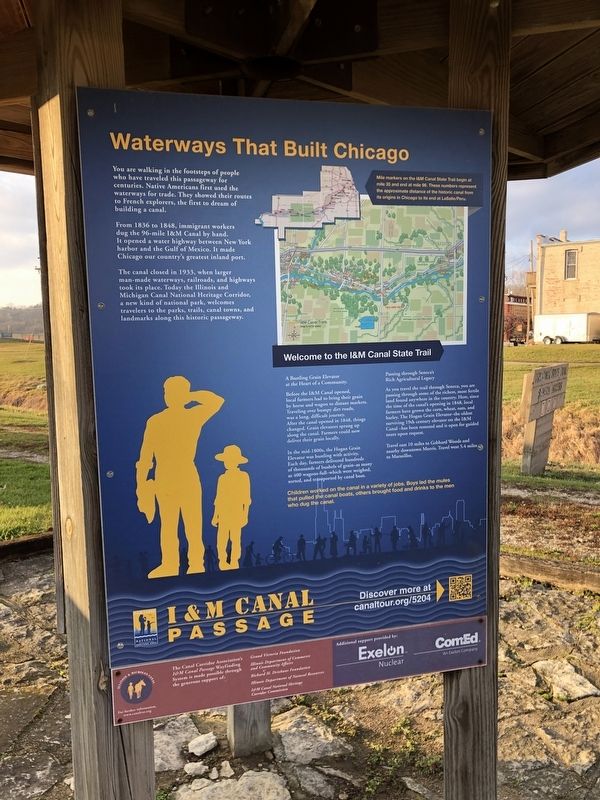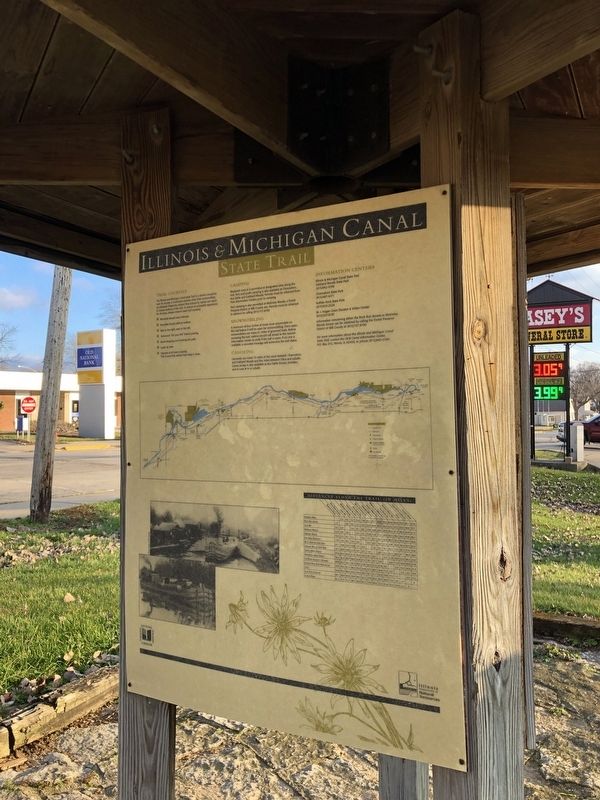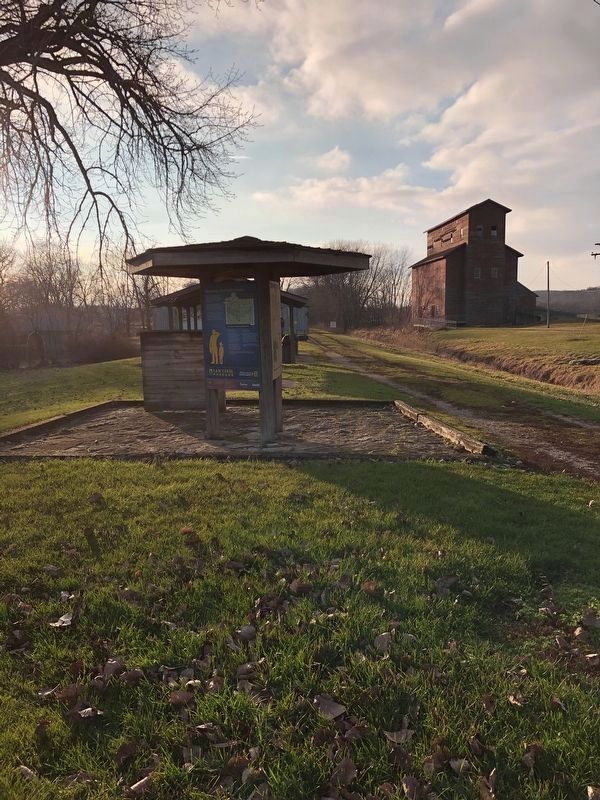Seneca in LaSalle County, Illinois — The American Midwest (Great Lakes)
Waterways that Built Chicago
Inscription.
You are walking in the footsteps of people
who have traveled this passageway for
centuries. Native Americans first used the
waterways for trade. They showed their routes
to French explorers, the first to dream of
building a canal.
From 1836 to 1848, immigrant workers dug the 96-mile I&M Canal by hand. It opened a water highway between New York harbor and the Gulf of Mexico. It made Chicago our country's greatest inland port.
The canal closed in 1933, when larger man-made waterways, railroads, and highways took its place. Today the Illinois and Michigan Canal National Heritage Corridor, a new kind of national park, welcomes travelers to the parks, trails, canal towns, and landmarks along this historic passageway.
Welcome to the I&M Canal State Trail
A bustling grain elevator at the heart of a community.
Before the I&M Canal opened, local farmers had to bring their grain by horse and wagon to distant markets. Traveling over bumpy dirt roads was a long, difficult journey. After the canal opened in 1848, things changed. Grain elevators sprang up along the canal. Farmers could now deliver their grain locally.
In the mid-1800s, the Hogan Grain Elevator was bustling with activity. Each day, farmers delivered hundreds of thousands of bushels of grain – as many as 400 wagons-full – which were weighed, sorted, and transported by canal boat.
Passing through Seneca's Rich Agricultural History
As you travel the trail through Seneca, you are passing through some of the richest, most fertile land found anywhere in the country. Here, since the time of the canal's opening in 1848, local farmers have grown the corn, wheat, oats and barley. The Hogan Grain Elevator – the oldest surviving 19th century elevator on the I&M Canal – has been restored and is open for guided tours upon request.
Travel east 10 miles to Gebhard Woods and nearby downtown Morris. Travel west 5.4 miles to Marseilles.
[Captions]
•Top: Mile markers on the I&M Canal State Trail begin at mile 35 and end at mile 96. These number represent the approximate distance of the historic canal from its origins in Chicago to its end at LaSalle/Peru.
• Children worked on the canal in a variety of jobs. Boys led the mules that pulled the canal boats, others brought food and drinks to the men who dug the canal.
Topics. This historical marker is listed in these topic lists: Agriculture • Industry & Commerce • Waterways & Vessels. A significant historical year for this entry is 1836.
Location. 41° 18.896′ N, 88° 36.612′ W. Marker is in Seneca, Illinois, in LaSalle County. Marker is on
North Main Street (Illinois Route 170) north of West Scott Street, on the left when traveling north. Touch for map. Marker is at or near this postal address: 225 N Main St, Seneca IL 61360, United States of America. Touch for directions.
Other nearby markers. At least 8 other markers are within 6 miles of this marker, measured as the crow flies. Landing Ship Tank Memorial (approx. 0.6 miles away); Marseilles Veterans Monument (approx. 5.2 miles away); Marseilles Civil War Memorial (approx. 5.2 miles away); Sgt. James Sanborn (approx. 5.2 miles away); Marseilles Veterans Memorial (approx. 5.2 miles away); The Death of “Big Steve” Sutton and the Birth of Laborers' Local Union 393 (approx. 5.2 miles away); Mistaken Shoot-out at Marseilles Dam (approx. 5.2 miles away); First Marine Division FMF Memorial (approx. 5.2 miles away).
Also see . . . Armour's Warehouse (PDF). National Register of Historic Places nomination (using a different name) for the grain elevator complex in Seneca, which was listed in 1997. (Prepared by Barbara J. Henning; via National Archives) (Submitted on January 14, 2024, by Duane and Tracy Marsteller of Murfreesboro, Tennessee.)
Credits. This page was last revised on January 14, 2024. It was originally submitted on January 13, 2024, by Duane and Tracy Marsteller of Murfreesboro, Tennessee. This page has been viewed 43 times since then. Photos: 1. submitted on January 13, 2024, by Duane and Tracy Marsteller of Murfreesboro, Tennessee. 2, 3. submitted on January 14, 2024, by Duane and Tracy Marsteller of Murfreesboro, Tennessee.


